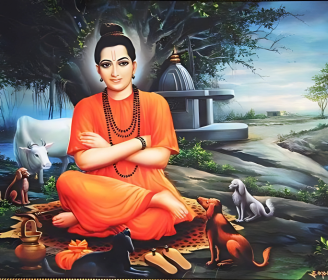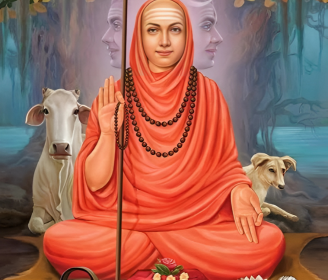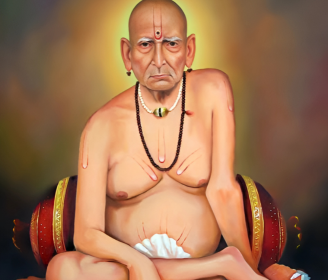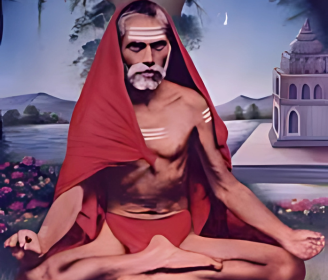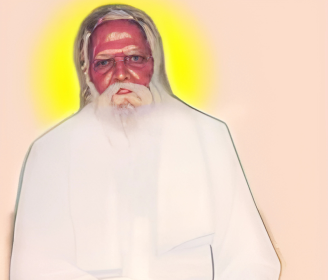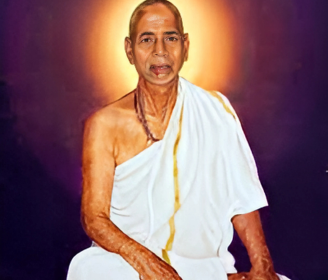
Shree Datta
Shree Datta
- Affiliation - Avatar of Narayana
- Abode - Varies per interpretation
- Mantra - Om Dram Dattatreya Namah
- Day - Thursday
- Festivals - Datta Jayanti
- Parents - Atri (father), Anasuya (mother)
- Consort - Anagha Devi
Dattatreya (Sanskrit: दत्तात्रेय), also known as Dattaguru or Datta, is a revered deity in Hinduism, widely regarded as an avatar of Lord Vishnu and a symbol of yogic wisdom. He is often depicted as a serene monk with three heads, representing the unified divine aspects of Brahma (the creator), Vishnu (the preserver), and Shiva (the destroyer). This unique form symbolizes his embodiment of the Trimurti’s collective energies. According to ancient scriptures such as the Bhagavata Purana, Markandeya Purana, and Brahmanda Purana, Dattatreya was born to Sage Atri and Devi Anusuya. One popular legend says the Trimurti themselves granted a boon to the couple, resulting in a divine child who manifested the powers and virtues of all three gods. While iconography commonly portrays Dattatreya as a three-headed ascetic, this is more symbolic than literal, and not all ancient texts reference such depictions.
Dattatreya is revered as a master of yoga and renunciation, and is credited as the author of the Avadhuta Gita—a profound scripture that explores the philosophy of non-duality (Advaita) and the nature of the liberated soul. He is also a central figure in several Upanishads, especially those rooted in Vedanta and Yogic traditions, highlighting his significance as a spiritual guide.
His teachings have profoundly influenced monastic movements within Shaivism, Vaishnavism, and Shaktism—especially in regions such as Maharashtra, Gujarat, Madhya Pradesh, Rajasthan, and the Himalayan belt, where Dattatreya is worshipped as both guru and deity. Saint-poet Tukaram, a leading figure of the Bhakti movement, praised Dattatreya’s simple life, compassion, and spiritual depth in his devotional verses.
Although most traditions agree on his divine parentage, legends vary about Dattatreya’s place of birth. Some scriptures mention Mahur in Maharashtra; others cite Kashmir, the Deccan region, or Pithapuram in Andhra Pradesh, where he is believed to have incarnated as Sripada Sri Vallabha, considered his first avatar. Despite the differing narratives, all sources highlight his renunciation of worldly life, deep meditation, and enlightened teachings.
One notable reference from the Tripura Rahasya describes a spiritual encounter between the sage Parasurama and Dattatreya, who was found in deep meditation on the Gandhamadana mountain near Rameswaram. Dattatreya is also said to have performed penance for 12,000 years, further establishing his place as a supreme yogi and spiritual master.
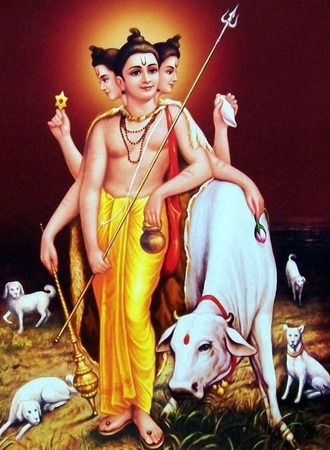
Self-education: The 24 Gurus of Dattatreya
In Hindu tradition, the young sage Dattatreya is revered for attaining self-realization without formal teachers. During his ascetic journey, he observed nature and considered 24 elements as his spiritual teachers. This story symbolizes the belief that wisdom can come from anywhere, and self-effort is a powerful path to enlightenment—especially embraced by yogis and artists.
| Sr no. | Guru | Observation | Dattatreya's Learning |
|---|---|---|---|
| 1 | Earth | Steadfast and resilient, it fulfills its dharma, endures abuse, heals itself, and continues to nourish and give selflessly | Forbearance means staying calm and composed even when faced with oppression. It is the strength to remain undisturbed in adversity and to continue healing and showing kindness, even when others cause harm |
| 2 | Wind | Like Truth, it moves through all things—unchanged and unattached—yet at times, it rises like a storm, shaking the world and bringing transformation. | "Be free like the wind, yet stay strong in your true power." |
| 3 | Sky | The highest truth is boundless and limitless—untouched by storms, clouds, or any passing disturbance. It remains constant, eternal, and unaffected by change. | The Atman, or true inner self, is eternal, infinite, and one with Universal Consciousness. Untouched by worldly illusions, it remains pure and non-dual. By transcending material distractions, you can realize your divine nature and unite with the Supreme Self. |
| 4 | Water | It serves all equally, without pride or discrimination—pure, transparent, and life-giving to everyone it touches. | A true saint shows no discrimination or pride, accepts others' impurities without judgment, yet always remains pure and spiritually uplifting. |
| 5 | Fire | Purifies, transforms, and energizes everything it touches—shaping and uplifting its surroundings | The transformative power of knowledge shapes everything it touches. To grow and evolve, one must fuel the self with the energy of continuous learning. |
| 6 | Moon | It waxes and wanes, yet its unity remains unchanged — a timeless lesson in learning | Birth, death, and rebirth are mere phases in the eternal cycle of existence. Like the moon’s changing phases, the soul remains one—unchanging, eternal, and ever-present |
| 7 | Sun | The Sun, our ultimate source of light, selflessly shares its energy with all living beings. Reflected uniquely in every rain puddle, it appears different—but remains the same one true Sun, offering its gift as a cosmic duty. | Though the soul appears different in each body, it is one and the same in all — just as the Sun shines for all, we too must share our gifts selflessly as a sacred duty. |
| 8 | Pigeons | They face harm from violent hunters and caution against forming obsessive attachments to people or material possessions. | Don't dwell on loss or damage—these are fleeting. Human life is a rare gift meant for self-discovery, learning, and attaining moksha (liberation). Focus on the soul's journey, not the temporary. |
| 9 | Python | Consumes everything in its path, efficiently extracting maximum value from all it ingests." Let me know the context (animal, business, product, etc.) for a more tailored version. | be content with what you have, make the most from life's gifts |
| 10 | Bumblebee | Active and hardworking, it selectively gathers nectar from flowers with care. It works in harmony with nature—never harming, over-consuming, or disrupting the floral ecosystem | Stay active and seek wisdom directly from its source. Learn from everywhere, but absorb only the best. Be kind, live in harmony, and respect other beliefs—walk away when needed. |
| 11 | Beekeeper | profits from honeybees | don't crave for material pleasures or in piling up treasures, neither the body nor material wealth ever lasts |
| 12 | Hawk | picks up a large chunk of food, but other birds harass him, when it drops its food other birds leave him alone | take what you need, not more |
| 13 | Ocean | Calm on the surface, yet deeply still within — receiving countless rivers without changing its essence. | Stay centered in who you truly are. Let life’s noise flow like rivers, without disturbing your inner peace. Seek self-knowledge, embrace your depth, and remain in perfect balance—calm, aware, and unshaken. |
| 14 | Moth | Misled by its senses, it rushes into the fire, unaware it’s chasing destruction. | question your senses, question what others are telling you, question what you see, know senses can deceive, seek reason |
| 15 | Elephant | Driven by lust, the elephant chases a mate’s scent, only to fall into a trap set by mahouts and end up captured and chained | Avoid desires for others or material pleasures—don’t get trapped by temptation or fleeting sensory gratification. Stay focused and self-aware. |
| 16 | Deer | is deceived by his fear, by hunters who beat drums and scare him into a waiting net | fear not the noise, and do not succumb to pressure others design for yo |
| 17 | Fish | is deceived by bait and so lured to its death | greed not the crumbs someone places before you, there are plenty of healthy opportunities everywhere |
| 18 | Courtesan | exchanges transient pleasure with body, but feels dejected with meaningless life, ultimately moves on | Many compromise their time, values, and self-respect for survival or success, only to feel unfulfilled. When disillusioned by their path, they often seek purpose, spirituality, and eventually move toward doing what they truly love. |
| 19 | Child | lives a life of innocent bliss | be a child, curious, innocent, blissful |
| 20 | Maiden | Despite her poverty, she lovingly feeds her family and guests. To hide her struggles, she cooks quietly, breaking all but one bangle on each wrist to avoid drawing attention. Her silent strength speaks volumes. | don't seek attention, a yogi accomplishes and shares more through solitude |
| 21 | Snake | lives in whatever hole that comes his way, willingly leaves bad skin and molts | a yogi can live in any place, must be ready to molt old ideas and body for rebirth of his spirit |
| 22 | Arrowsmith | the best one was so lost in his work that he failed to notice the king's procession that passed his way | concentrate on what you love to do, intense concentration is the way to self-realization |
| 23 | Spider | builds a beautiful web, destroys and abandons the web, then restarts again | don't get entangled by your own web, be ready to abandon it, go with your Atman |
| 24 | Caterpillar | Begins life in a small cocoon, then transforms into a beautiful butterfly | Every great spiritual journey begins with a small step. A humble disciple, though seemingly insignificant at first, evolves into a revered spiritual master over time. |
Dattatreya Iconography
Lord Dattatreya is widely depicted with three heads and six hands, representing the Trimurti—Brahma, Vishnu, and Shiva. His hands hold sacred symbols: japamala and kamandalu (Brahma), shankha and chakra (Vishnu), and trishula and damaru (Shiva). Often shown as a simple monk in forests or mountains, he embodies yogic wisdom and renunciation. A distinctive feature of Dattatreya’s iconography includes four dogs (symbolizing the four Vedas) and a cow, representing Mother Earth and universal nourishment. While the three-headed form is most common, older temples in Mahur, Narayanpur, Pandharpur, Varanasi, Nepal, and the Himalayas—especially those linked to Nath yogis—depict him with one head and two or four hands, as referenced in ancient texts like the Agni Purana. Revered as the “honeybee yogi,” Dattatreya blends Advaita Vedanta with diverse yogic paths, symbolizing spiritual unity, non-duality, and the eternal guru principle in Hinduism.
Alternate iconography
Ancient sculptures of Lord Dattatreya, dating back to the 1st millennium CE, have been found in Hindu cave temples like Badami in Karnataka. One notable relief shows him with one head and four arms in padmasana, symbolizing the Trimurti—Brahma’s swan, Vishnu’s Garuda, and Shiva’s Nandi. His form blends attributes of Shiva and Vishnu, reflecting divine unity.
A similar 4-armed statue found in Ajmer, Rajasthan, holds a Trishul, Chakra, Kamandalu, and rosary—representing Shiva, Vishnu, and Brahma. These sculptures beautifully illustrate Lord Dattatreya as the embodiment of the Trimurti in ancient Indian art and devotion.
Symbolism
In Hindu scriptures, Lord Dattatreya’s iconography is deeply symbolic. His three heads represent the three Gunas—Sattva (purity), Rajas (activity), and Tamas (inertia)—as described in the Samkhya philosophy. His six hands symbolize core ethical values in Yoga and Vedanta: Yama, Niyama, Sama, Dama, Daya, and Shanti.
The Kamadhenu cow beside him represents the five elements (Panchabhutas), while the four dogs symbolize inner human drives Iccha (will), Vasana (desire), Asha (hope), and Trishna (craving). These elements illustrate that Dattatreya, the enlightened yogi & guru, has mastered all material & mental forces, standing beyond worldly limitations as a true spiritual guide.
Incarnation of Dattatreya
Dattatreya traditions
Lord Dattatreya is revered across multiple Hindu monastic and spiritual traditions, shaping diverse paths of yogic and devotional practice:
- Nath Sampradaya: Dattatreya is regarded as the spiritual founder of the Nath tradition, which gained prominence between the 10th and 18th centuries, especially during the Islamic invasions. Prominent in Maharashtra, Gujarat, Rajasthan, and Uttar Pradesh, Nath yogis such as Gorakshanath were deeply influenced by Dattatreya.
Avadhuta Sampradaya: Associated with the nine Narayanas, this tradition traces its roots to Dattatreya. Saint Pantmaharaj Balekundrikar of Belagavi and Shri Prabhakar Keshavrao Motiwale (Kanadia Ashram, Indore) are key figures continuing this lineage.
Dasanami & Shakta Traditions: Dattatreya is venerated in the Advaita-based Dasanami order and Shakti worship traditions, bridging non-dualism and divine feminine reverence.
Bhakti Movement: Saints like Tukaram and Eknath invoked Dattatreya in their poetry, praising his teachings of simplicity, compassion, and spiritual self-inquiry during times of social unrest.
Mahanubhava Panth: This Krishna-centric sect honors Dattatreya as their Adi Guru. He is worshipped as a two-armed deity, with a dedicated temple in Mahur.
Gurucharitra Tradition: Based on the sacred Marathi text Shri Gurucharitra, this tradition focuses on the lives of Datta Avatars Sripada Srivallabha and Narasimha Saraswati. Ganagapur in Karnataka is a key pilgrimage site.
Manik Prabhu Sampradaya: Founded by 19th-century saint Shri Manik Prabhu, this tradition worships Dattatreya with his consort Madhumati. Manik Nagar serves as its spiritual center, rich with devotional literature in Marathi and Kannada.
Lal Padris: A yogic sect from western India that aligns with Nath principles, they trace their spiritual roots to Dattatreya.
Telugu Dattatreya Tradition: Saint Dattatreya Yogi passed his teachings to Das Gosavi, who, along with Paramanandateertha, played key roles in shaping the Advaita-inspired Telugu Dattatreya philosophy, later expanded through translations in Kannada and Marathi.
